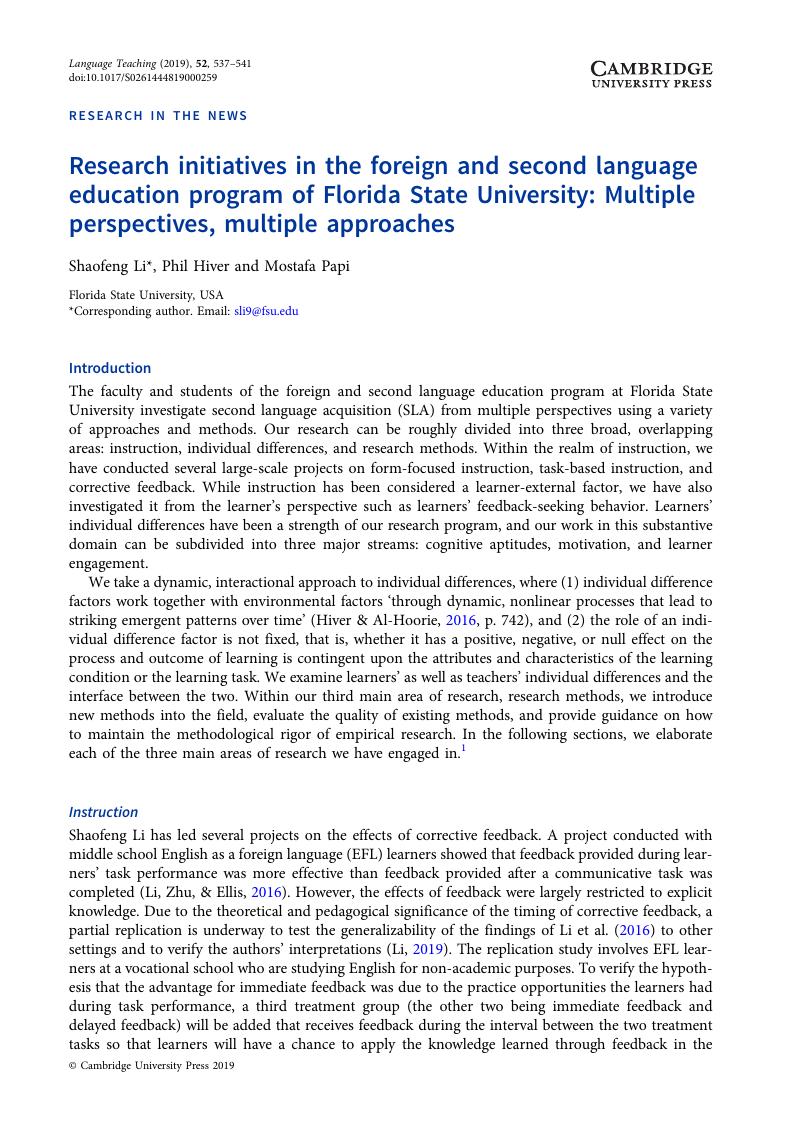No CrossRef data available.
Article contents
Research initiatives in the foreign and second language education program of Florida State University: Multiple perspectives, multiple approaches
Published online by Cambridge University Press: 29 July 2019
Abstract
An abstract is not available for this content so a preview has been provided. Please use the Get access link above for information on how to access this content.

- Type
- Research in the news
- Information
- Copyright
- Copyright © Cambridge University Press 2019
References
Dörnyei, Z. (2009). The L2 motivational self system. In Dörnyei, Z. & Ushioda, E. (Eds.), Motivation, language identity and the L2 self (pp. 9–42).Bristol: Multilingual Matters.Google Scholar
Dweck, C. S. (1999). Self-theories: Their role in motivation, personality, and development. Philadelphia: Psychology Press.Google Scholar
Ellis, R., Li, S., & Zhu, Y. (2019). The effects of pre-task explicit instruction on the performance of a focused task. System, 80, 38–47.Google Scholar
Han, J., & Hiver, P. (2018). Genre-based L2 writing instruction and writing-specific psychological factors: The dynamics of change. Journal of Second Language Writing, 40, 44–59.Google Scholar
Hiver, P., & Al-Hoorie, A. H. (2016). A dynamic ensemble for second language research: Putting complexity theory into practice. Modern Language Journal, 100(4), 741–756.Google Scholar
Hiver, P., & Dörnyei, Z. (2017). Language teacher immunity: A double-edged sword. Applied Linguistics, 38(3), 405–423.Google Scholar
Hiver, P., Mercer, S., & Al-Hoorie, A. H. (Eds.) (forthcoming). Engagement in the second language classroom. Bristol: Multilingual Matters.Google Scholar
Li, S. (2019). What is the ideal time to provide corrective feedback? Language Teaching, doi:10.1017/S026144481800040XGoogle Scholar
Li, S., Ellis, R., & Zhu, Y. (2019). The associations between cognitive ability and L2 development under five different instructional conditions. Applied Psycholinguistics 40(3), 693–722.Google Scholar
Li, S., & Wang, H. (2018). Traditional literature review and research synthesis. In Phakiti, A., De Costa, P., Plonsky, L., & Starfield, S. (Eds.), Palgrave handbook of applied linguistics research methodology (pp. 123–144). London: Palgrave.Google Scholar
Li, S., Zhu, Y., & Ellis, R. (2016). The effects of the timing of corrective feedback on the acquisition of a new linguistic structure. Modern Language Journal, 100, 276–295.Google Scholar
Papi, M. (2018). Motivation as quality: Regulatory fit effects on incidental vocabulary learning. Studies in Second Language Acquisition 40(4), 707–730.Google Scholar
Papi, M., Bondarenko, A., Mansouri, S., Feng, L., & Jiang, C. (2019). Rethinking L2 motivation: The 2X2 model of self-guides. Studies in Second Language Acquisition, 41(2), 337–361.Google Scholar
Papi, M., Rios, A., Pelt, H., & Ozdemir, E. (2019). Language learners’ feedback-seeking behavior: Basic components and motivational antecedents. Modern Language Journal, 103(1), 205–226.Google Scholar
Yun, S., Hiver, P., & Al-Hoorie, A. H. (2018). Academic buoyancy: Exploring learners’ everyday resilience in the language classroom. Studies in Second Language Acquisition, 40, 805–830.Google Scholar




